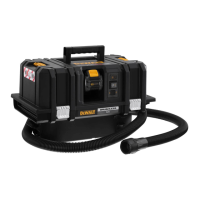6
ENGLISH
Specific Safety Rules for Dust Extractors
• The appliance may only be used by persons who are familiar
with it, have been trained on how to use it safely and who
understand the resulting hazards.
• When picking up dusts with an exposure limit value,
precautions must be taken to ensure adequate air exchange
in the room if the exhaust air from the appliance is released
into the room.
• Operator should observe any safety regulations to the material
beinghandled.
• Do not use to vacuum combustible explosive materials, such
as coal, grain, or other finely divided combustiblematerial.
• Do not use the appliance to pick up flammable or combustible
liquids, such as gasoline, or use in areas where flammable or
combustible liquids arepresent.
• Do not use to vacuum hazardous, toxic or carcinogenic
materials, such as asbestos or pesticide, unless the vacuuming
of the material is specifically identified in this instruction
manual as an approveduse.
• Static shocks are possible in dry areas or when the relative
humidity of the air is low. This is only temporary and does not
affect the use of thedustextractor.
• To avoid spontaneous combustion, empty the canister after
everyuse.
• Some wood contains preservatives which can be toxic. Take
extra care to prevent inhalation and skin contact when
working with these materials. Request and follow any safety
information available from your materialsupplier.
• Do not use vacuum as a stepladder.
• Do not place heavy objects ondustextractor.
WARNING: To reduce the risk of fire, electric shock and
injury:
• Do not pick up anything that is burning or smoking,
such as cigarettes, matches or hotashes.
• Do not use without filter inplace.
Residual Risks
In spite of the application of the relevant safety regulations
and the implementation of safety devices, certain residual risks
cannot be avoided. These are:
• Impairment ofhearing.
• Risk of personal injury due to flyingparticles.
• Risk of burns due to accessories becoming hot
duringoperation.
• Risk of personal injury due to prolongeduse.
Electrical Safety
The electric motor has been designed for one voltage only.
Always check that the battery pack voltage corresponds to the
voltage on the rating plate. Also make sure that the voltage of
your charger corresponds to that of yourmains.
Your
charger is double insulated in
accordance with EN60335; therefore no earth wire
isrequired.
If the supply cord is damaged, it must be replaced by a
specially prepared cord available through the
serviceorganisation.
Mains Plug Replacement
(U.K. & Ireland Only)
If a new mains plug needs to be fitted:
• Safely dispose of the oldplug.
• Connect the brown lead to the live terminal in theplug.
• Connect the blue lead to the neutralterminal.
WARNING: No connection is to be made to the
earthterminal.
Follow the fitting instructions supplied with good quality plugs.
Recommended fuse: 3A.
Using an Extension Cable
An extension cord should not be used unless absolutely
necessary. Use an approved extension cable suitable for
the power input of your charger (see Technical Data). The
minimum conductor size is 1mm
2
; the maximum length
is30m.
When using a cable reel, always unwind the cablecompletely.
SAVE THESE INSTRUCTIONS
Chargers
chargers require no adjustment and are designed to be
as easy as possible tooperate.
Important Safety Instructions for All Battery
Chargers
SAVE THESE INSTRUCTIONS: This manual contains important
safety and operating instructions for compatible battery
chargers (refer to TechnicalData).
• Before using charger, read all instructions and cautionary
markings on charger, battery pack, and product using
batterypack.
WARNING: Shock hazard. Do not allow any liquid to get
inside charger. Electric shock mayresult.
WARNING: We recommend the use of a residual current
device with a residual current rating of 30mA orless.
CAUTION: Burn hazard. To reduce the risk of injury,
charge only
rechargeable batteries. Other types of
batteries may burst causing personal injury anddamage.
CAUTION: Children should be supervised to ensure that
they do not play with theappliance.
NOTICE: Under certain conditions, with the charger
plugged into the power supply, the exposed charging
contacts inside the charger can be shorted by foreign
material. Foreign materials of a conductive nature such
as, but not limited to, steel wool, aluminum foil or any
buildup of metallic particles should be kept away from
charger cavities. Always unplug the charger from the
power supply when there is no battery pack in the cavity.
Unplug charger before attempting to clean

